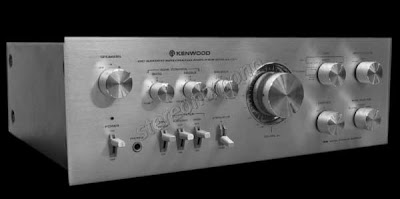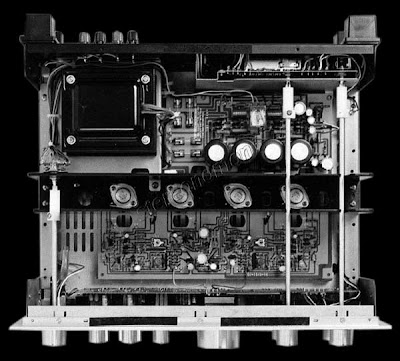
Kenwood's superior tonal quality is again demonstrated by the low distortion characteristic of the model KA-7100. With its professional features, such as our exclusive DC power amplifier and independent dual power supplies and many circuitry innovations, the KA-7100 is a truly outstanding amplifier with amazing value.
kenwood's exclusively developed DC power amplifier has very low distortion and excellent transient response. Separate power supplies for each channel reduce Dynamic Crosstalk distortion to negligible levels, providing purer sound quality. Total Harmonic Distortion is a very low 0,02% over the 20 -20,000 Hz audio range. Signal-to-noise ratio measures a high 80 dB (IHF A) at the phono inputs. And there's a superior tone control sysytem, attenuator-type volume control and two-steps loudness control to let you contur the sound to match your room characteristics and individual needs.

New DC Power Amplifier
The development of the DC power amplifier can be counted as one of our most significant engineering successes, because it provides an almost perfect linear frequency response that starts virtually from 0 Hz. What this means is that the signal amplified has effectively the same waveform as that at the input terminals. The amplifier maintains extremely low distortion right down to the ultra-low frequency range. With excellent phase and transient characteristics - the response in actual conditions of musical reproduction - the sound that you hear is perfectly natural. The direct-coupled amplifer consist of a three-stage differential circuit (with a dual-gate FET in the first stage) and our power amplifier circuitry, assuring ample, highly stable, effective power output. To safeguard all circuit , and your precious speakers, there's a built-in limiter protection circuit and protection relays. With phase and transient distortion both at negligible levels, the KA-7100 provides a refreshing clarity and "roundness" of sound even at high volume levels.
Direct-Coupled, FET Equalizer Section
The high signal-to-noise ratio of 80 dB at the phono inputs is the result of a carefully designed three-stage ICL (input capacitorless) circuit, using FET's in the first stage. This provides good phase and transient response. The class A amplifier with constant current output provides low distortion signal reproduction throughout the audible range. Tracking of the RIAA curve is so accurate, in fact that deviation from it is never more than +/- 0,2 dB. The max. phono input level,by the way is an unusually high 200 mV, so there's no danger of overloading when you're playing passages of exceptional dynamic range.

Independent Dual Power Supplies For Right and Left Channels.
One of the drawbacks of conventional amplifiers is that a single power supply creates Dynamic Crosstalk distortion - a form of distortion discovered by Kenwood engineers.. Dynamic Crosstalk has been largely overlooked in normal laboratory measuring methods which do not reveal the dynamic distortion in an amplifier appearing in conditions of actual musical reproduction. The power transformer has a large EI core and two separate windings, and there are four 6,000 μF electrolytic capacitors. As well as this, a full-scale voltage regulator using transistors is employed in the pre-amplifier stage to prevent any interference between amplifier stages. By significantly reducing Dynamic Crosstalk distortion, there is a great improvement in transient response and damping. This allows each musical instrument to be heard in its correct location in the stereo sound field, and at its natural level. Reproduced sound, right down to the 1st octave is wonderfully crisp and clear.
Sophisticated Tone Controls Make You Master of Your Sound.
Tonal purity gets top priority at Kenwood and many of our design innovations and improvements have been transparent, distortion-free sound possible. The tone control system of the KA-7100 has been devised to enable you to match the acoustic characteristics of your roomand of the music you play, so that you can, in effect, "tailor" the sound. Baxandall-type low-distortion negative feedback tone circuits are employed to give both precision and stability. Attenuation is made in 1,5 dB click-stop steps over a maximum range of +/-7,5 dB. An inportant feature is that the tone defeat completely bypasses the control section in order to maintain excellent tonal quality.

Unique Tape-Through Circuitry
Kenwood's now familiar tape-through circuit allows you to listen to a completely different source while recording or dubbing. You can record simultaneously on one or two tape decks, and monitor both tape inputs, and you can dub from A to B.
Two-stage Loudness Control
The loudness control boosts the lower frequencies which would otherwise roll off when the volume is turned down vrey low. position 1 boosts by 3 dB (at 100 Hz) and Position 2 boosts by 6 dB (at 100 Hz) at -30 dB volume level. This gives a more natural, balenced sound when you are listening at low level.
High Frequency and Subsonic Filters
High frequency noises, record scratch etc, can be cut by a high filter which cuts off at 8 kHz. Similarly, record warp (there are more warped records than you think) or other subsonic influences, which could affect your speakers, can be eliminated by a subsonic filter which has a cut-off point of 20 Hz. Both have characteristic slopes of 6 dB/oct.

Specifications:
Power Amplifier Section
Both Channels Driven: 2 x 60 watts, 8 ohms at 1 kHz; 2 x80 watts, 4 ohms at 1 kHz
Dynamic Power Distortion: 250 watts 4 ohms
Total harmonic Distortion: 0.02% at rated power into 8 ohms; 0.02% at 1 watt into 8 ohms
Intermodulation Distortion (60 Hz : 7 kHz = 4 ; 1):
0.01% at rated power into 8 ohms; 0.01% at 1 watt into 8 ohms
Power Bandwidth: 5 Hz to 45,000 Hz
Frequency Response: DC to 100,000 Hz +0 dB, -1,5 dB
Signal to Noise Ratio: 120 dB (short circuited)
Damping Factor: 50 at 8 ohms
Speaker impedance: from 4 to 16 ohms
Preamplifier Section
Input Sensitivity/Impedamce:
Phono : 2,5 mV/50 kohms,
Tuner, Tape , Aux: 150 mV/50 kohms
Signal to Noise Ratio (IHF .A):
Phono : 80 dB for 2,5 mV , 86 dB for 5,0 mV , 92 dB for 10 mV input
Tuner, AUX, Tape : 110 dB for 150 mV input
Maximum input Level for Phono 1: 250 mV (RMS), THD 0,02% at 1 kHz
Output Level/Impedance:
Tape REC (PIN): 150 mV/450 ohms
Tape REC (DIN): 30 mV/80 kohms
Frequency Response:
Phono: RIAA standard curve +0,2 dB, -0,2 dB
AUX, Tape: 10 Hz to 100,000 hZ +0 dB, -1.8 dB
Tone control:
Bass : ±7.5 dB at 50 Hz
Treble: ±7.5 dB at 10,000 Hz
Loudness Control (at -30 dB Volume Level): at 100 Hz 1) +3 dB, 2) +6 dB, 3
Subsonic Filter: 20 Hz, 6dB/oct
High Filter: 8 kHz, 6 dB/oct
General
Power Requirements: 50/60 Hz 120 - 240 V
Power Consumption: 460 watts
A.C. Outlet: Switched 2, Unswitched 1
Dimensions (W x H x D): 430 x 149 x 384 mm (15-15/16" x 5-7/8" x 15-1/8")
Weight: 11,5 kg (11,5 lbs) Net

Nessun commento:
Posta un commento